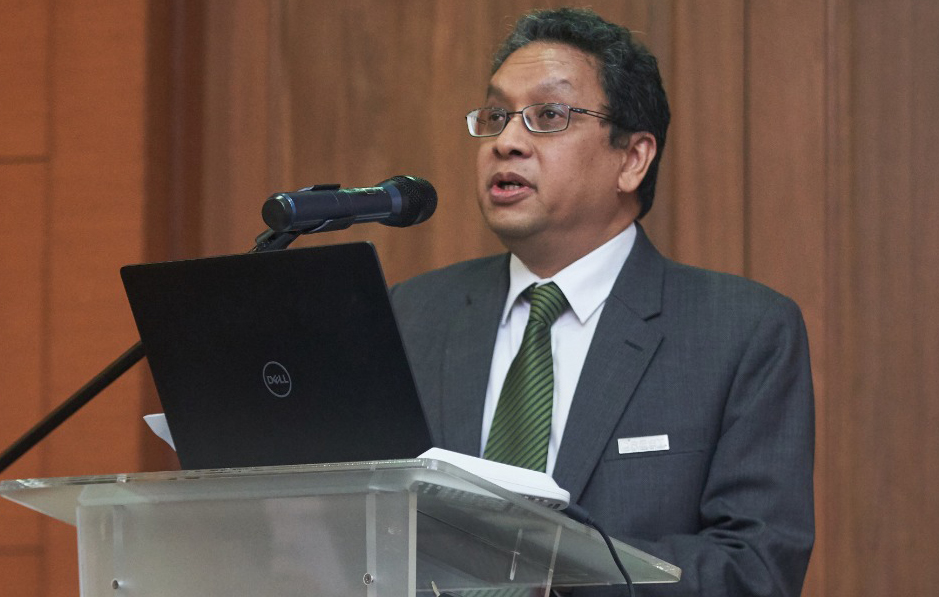CREST: Seven years of leading the wave
By Dzof Azmi July 24, 2019
- CREST 2.0 currently in development; aims to build in-depth expertise
- Time to build substantial depth in key areas and become experts

JAFFRI Ibrahim (pic) is sitting behind his desk holding an almost nondescript white box with a surface that is punctured by a bright blue light.
"The light is up to one hundred times brighter than the brightest light you can find today," observes Jaffri. “And it takes a quarter of the energy to power it.”
The CEO of Collaborative Research in Engineering, Science and Technology (CREST) is talking about the blue LED, made in part with an epitaxy of gallium nitride on a substrate of the same material. "We started by saying in 2012, that (we) wanted to do front-end research on epitaxy," he says. "We have the capability today."
The lighted box, is in fact, the very first blue LED built in Malaysia. He admits that perhaps he should take better care of what is a piece of Malaysian engineering history, but he has a right to lay some claim to it, given CREST's role in bringing the players together.
It all started when Shuji Nakamura, the inventor of the blue LED, happened to be presenting a paper at an event organised by the Electronic and Engineering (E&E) industry in Penang. "Some of the guys here recognised him of course, and went up to him after his paper and said, hey Shuji do you want work together? He answered, okay, why not?"
Shuji’s first offer was to invite Malaysian researchers to work in his lab. Except, Jaffri believed there could be much more. He reached out to the Electrical and Engineering (E&E) industry in Penang.
“What do you make out of this?" Jaffri recalls asking. "Then one of the guys from Osram came up and said, why don't we counter-propose?"
Now, Malaysian engineers and researchers from the University of California, Santa Barbara split their time between the research lab in the US, and two labs in Malaysia specially built to duplicate what is in California.
"Guess what?" exclaims Jaffri. "We already have the recipe now to develop a blue LED in Malaysia!"
Multinational demand, local benefit
The story may make it sound like a lucky accident, but for Jaffri, what CREST does is very deliberate.
"It's like a meeting place where you can explore the collaboration between companies, industry and academia," he says. "You can always go to CREST and tell them what you need and we will find someone for you to collaborate with.
"The people who made the case for CREST to be formed were really the multinationals," admits Jaffri. "They wanted to bring the strength of a company, academia and government to work together."
What the multinationals wanted was for the Penang E&E industry to be a strong ecosystem. It would help them in pitching to headquarters to get top-end projects to be led by the Penang office.
If it involved some cutting-edge technology (for example, 5G), then it would help their case to say they can try to collaborate with a local university already doing the relevant research.
The multinationals worked hard to convince the government that they were serious.
"The industry came up with a sort of bill of guarantees to the government," recalls Jaffri. "Among them was that they will represent themselves in the board at the most senior level there."
Other guarantees made were that the industry would open up their labs and share IP in areas that were not too crucial for them. There was even a sort of guarantee on ROI. "Every dollar the government spent, we want to turn it around to offer seven times the return on that dollar," says Jaffri.
"Every single point was actually delivered on by the industry in a way," he continues. "Whenever we wanted to meet somebody senior in the government, I just called the senior people in Penang. I would say, I need you and they'll be there in a flash, fighting for you!"
With great support from the industry, great responsibility was expected from CREST. "They tested us by saying, if you are serious, we're double serious and be honest with us if you can't do it, just tell us you can’t do it but you're trying," remembers Jaffri. "But when you promise something, you damn well give it a shot!"
"Thank God that we were equally serious," says Jaffri. "I think the strategy that we shared with them from day one up to today is still very relevant"
However, when the criticism is raised that if MNCs are contributing so much, they might end up controlling the agenda, Jaffri is quick to point out that the majority of their projects are led by local companies, not the MNCs.
"More local companies now realise that hey, there's things to do here that will benefit them but that would never have happened if the multinationals didn't start doing it."
Going forward
This has been a journey of seven years, and Jaffri already has his sights trained ahead towards the future.
"We've been approached by the Ministry of Finance and they're asking us what's next with CREST?" he says. "We have spent the last few months developing the CREST 2.0 model."
In particular, Jaffri feels the time has passed to snatch at the low-hanging fruits of quick and easy successes, and instead they need to take the time to build substantial depth in key areas - something the Penang E&E industry is well familiar with, having had decades of experience in electrical engineering.
"We hope we will go in depth," he explains. "Go deep into the sciences, we want to be experts."
Related Stories :


